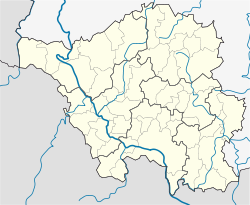You can help expand this article with text translated from the corresponding article in German. (October 2018) Click for important translation instructions.
|
| Abtei Fraulautern | |
 Fraulautern Abbey, 1865, with in the foreground the new railway line on the Saar, on the left the abbey mill (Klostermühle), in the middle the Baroque abbey church, on the right the gatehouse Fraulautern Abbey, 1865, with in the foreground the new railway line on the Saar, on the left the abbey mill (Klostermühle), in the middle the Baroque abbey church, on the right the gatehouse | |
  | |
| Monastery information | |
|---|---|
| Order | Augustinian canonesses |
| Established | 12th century |
| Dedicated to | St. Augustine |
| Site | |
| Location | Saarlouis in Saarland, Germany |
| Coordinates | 49°19′23″N 6°45′47″E / 49.32306°N 6.76306°E / 49.32306; 6.76306 |

Fraulautern Abbey (German: Abtei Fraulautern; Latin: Abbatia in Lutrea) was a community of Augustinian canonesses of the nobility, founded in the 12th century; it was suppressed in the 1790s during the French Revolution.
Abbey buildings
The abbey buildings, which are still extant in part, are located in Fraulautern, now part of Saarlouis in Saarland, Germany. Between the French Revolution and 1936, when Fraulautern was incorporated into Saarlouis (then known as Saarlautern), the buildings were used as the town hall. They are now used by the Grundschule of Fraulautern under the name "Im Alten Kloster".
Abbesses
From R. Rudolf Rehanek:
- c. 1160: Margarethe
- 1169–1197: ?
- c. 1225: Meisterin J.
- 1225–1236: ?
- 1241: Berta
- 1260: Jutta
- 1262–1269: ?
- 1269–1279: Gertrud
- 1289: Elsa
- 1296: Havils Nonneyer
- 1299, 1303: Mathilde von Herbitzheim
- 1308–1312: Hanvela
- 1312–1335: Elisabeth von Saarbrücken
- 1353–1344: Hildegarde
- 1344: Esebet
- 1354: ?
- 1357–1373: Gudela
- 1395: Aleyt von Castel
- 1403: Lysa von der Neuerburg
- 1406, 1443: Katharina von Wolfstein
- 1448–1472: Margarethe von Huntingen
- 1472–1492: Katharina von Bettingen
- 1492–1507: Eva Huberissen von Schellodenbach (Schallodenbach)
- 1507–1522: Margarethe von Wolfstein / Gertrud Brederin von Hohenstein
- 1550–1560: Hildegard von Becheln
- 1565–1587: Margarethe von Bübingen / Apollonia von Gressnich
- 1587–1598: Apollonia von Gressnich / Agnes Braun von Schmidtburg
- 1617–1622: Johanetta von Wiltz
- 1622–1626: Anna Maria von Geispoltzheim
- 1626–1633: Gabriele de Braubach
- 1646–1677: Dorothea Braun von Schmidtburg
- 1677–1691: Carolina von Hagen
- 1691–1695: Arnolda Elisabeth von Weller
- 1700: Odilia Braun von Schmidtburg
- 1708: A. E. von Metzenhausen
- 1720–1730: A. M. von Geispitzheim
- 1730–1757: Maria Theresia de Saintignon
- 1757–1773: Maria Helene von Rathsamshausen
- 1773–1791: Sophie von Neuenstein

References
- Bernhard Kirsch: Artikel "Warum heißt die Saar "Saar" oder wer war vor den Kelten da?", in: Unsere Heimat, Mitteilungsblatt des Landkreises Saarlouis für Kultur und Landschaft, 41. Jahrgang, Heft Nr. 2, 2016, p.45–56, hier S. 49.
- Saarforschungsgemeinschaft (Hrsg.): Die Kunstdenkmäler der Kreise Ottweiler und Saarlouis, bearbeitet von Walter Zimmermann, 2., unveränderte Auflage von 1934, (Saarbrücken 1976), p.191.
- R. Rudolf Rehanek: Geschichte der Kreisstadt Saarlouis, Band 1: Die hochadelige Frauenabtei und das Dorf Fraulautern, (Saarlouis 1978), p.17–19.
- R. Rudolf Rehanek: Geschichte der Kreisstadt Saarlouis, Band 1: Die hochadelige Frauenabtei und das Dorf Fraulautern, (Saarlouis 1978), p. 129–130.
This article about a German religious building or structure is a stub. You can help Misplaced Pages by expanding it. |